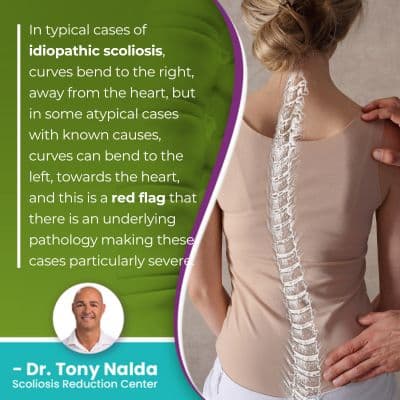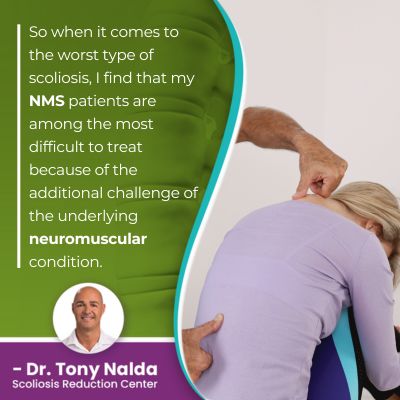Discover What Is the Worst Type of Scoliosis [Explained]

There are different severity levels and types of scoliosis, and all types are progressive, meaning it's the condition's nature to get worse over time, so counteracting progression is a large focus of treatment. Continue reading to learn what makes some types of scoliosis more serious than others, although all require treatment.
There are different types of scoliosis with unique characteristics and treatment needs. Typical idiopathic scoliosis has no known cause, but scoliosis with known causes are atypical and can be particularly severe, the worst of which is neuromuscular scoliosis.
As part of diagnosing scoliosis involves further classifying conditions based on key variables, let's start with how the condition is diagnosed and classified.
Table of Contents
Diagnosing Scoliosis
Diagnosing scoliosis isn't always easy; many cases are subtle with signs that are difficult to recognize, and as a progressive condition, where a patient's scoliosis is at the time of diagnosis isn't indicative of where it will stay.
Scoliosis is diagnosed when an unnatural sideways-bending and twisting spinal curve has developed, and an X-ray confirms the rotational component and determines condition severity.
There are a number of spinal conditions that cause a loss of the spine's healthy curves, but scoliosis also has a rotational component, and the size of the unnatural spinal curvature has to be a minimum of 10 degrees to be diagnosed as scoliosis.
There are a number of factors that shape a patient's experience of life with the condition, and a significant one is severity, and this is determined by a measurement known as Cobb angle.
A patient's Cobb angle is determined during X-ray by drawing lines from the tops and bottoms of the curve's most-tilted vertebrae, and the resulting angle is expressed in degrees and determines severity.
The higher a patient's Cobb angle, the further out of alignment the spine is and the more severe the condition:
- Mild scoliosis: Cobb angle measurement of between 10 and 25 degrees
- Moderate scoliosis: Cobb angle measurement of between 25 and 40 degrees
- Severe scoliosis: Cobb angle measurement of 40+ degrees
- Very severe scoliosis: Cobb angle measurement of 80+ degrees
In typical cases of idiopathic scoliosis, the worst cases are those that are severe and very severe; the more severe, the more noticeable the curve is and the more noticeable its effects are likely to be.
 In typical cases of idiopathic scoliosis, curves bend to the right, away from the heart, but in some atypical cases with known causes, curves can bend to the left, towards the heart, and this is a red flag that there is an underlying pathology making these cases particularly severe.
In typical cases of idiopathic scoliosis, curves bend to the right, away from the heart, but in some atypical cases with known causes, curves can bend to the left, towards the heart, and this is a red flag that there is an underlying pathology making these cases particularly severe.
Atypical Condition Types
Atypical condition types with known causes include neuromuscular scoliosis, degenerative scoliosis, and congenital scoliosis, and because they are atypical, they can be severe and have unique treatment needs.
When a curve is atypical and curves to the left, this is known as levoscoliosis, and typical curves that bend to the right are known as dextroscoliosis.
When scoliosis has a known cause, it has to be the focus of treatment as this is the difference between merely addressing a condition's symptoms, or their underlying cause: the condition itself.
Degenerative Scoliosis
Degenerative scoliosis affects older adults and is caused by natural age-related spinal degeneration; degenerative changes in the spine commonly start with its intervertebral discs.
Degenerative disc disease is a contributing factor in the development of a number of spinal conditions and issues because of the many roles the discs play in preserving spinal function.
The spine consists of vertebrae (bones) stacked on top of one another, and each pair of adjacent vertebrae are separated by an intervertebral disc.
The discs combine forces to facilitate the spine's flexibility, provide cushioning between vertebrae so friction isn't generated during movement, they give the spine structural support (adjacent vertebrae attach to the disc in between), and they act as these spine's shock absorbers.
So considering the many roles the discs play in preserving spinal health, it's not surprising that if one or more discs start to degenerate and change shape as a result, they can affect the position of nearby vertebrae.
Degenerative scoliosis is most common in adults over the age of 50 and is more common in females, and this is due to hormone and bone density changes caused by menopause.
As spinal degeneration is a factor, the spine is becoming increasingly unbalanced and unstable, so scoliosis can progress quickly in older adults.
Congenital Scoliosis
Cases of congenital scoliosis are rare, affecting approximately 1 in 10,000.
Congenital scoliosis involves a malformed spine that develops in utero, so babies are born with the condition, and these cases often involve additional congenital abnormalities so patients need to be comprehensively assessed and monitored.
Spinal malformations can involve some vertebral bodies being more triangular in shape than rectangular, causing the spine to wedge forward and develop an unnatural curve.
There are also malformations that involve the failure of vertebral bodies to form into distinct and separate bones, instead becoming fused together as one solid bone that disrupts the spine's ability to develop normally.
Congenital scoliosis can be severe, particularly when growth triggers progression.
Neuromuscular Scoliosis
When it comes to neuromuscular scoliosis, this is generally considered the worst type of scoliosis, and this is because its underlying cause is the presence of a larger neuromuscular condition.
There are a number of neuromuscular conditions that can cause the onset of scoliosis, including spina bifida, cerebral palsy, and muscular dystrophy.
While having a neuromuscular condition doesn't guarantee the onset of scoliosis, it is a common complication, and because there is a larger medical condition behind its development, I can't offer my neuromuscular scoliosis patients the same types of prognoses that I can in typical cases of idiopathic scoliosis.
In NMS, the neuromuscular condition has to be the focus of treatment, which complicates the process.
Neuromuscular conditions capable of causing scoliosis involve a disconnect between the brain, the spine, and the muscles and/or connective tissues that support the spine, and this can cause some patients to become unable to walk on their own and wheelchair bound.
Neuromuscular curves tend to be more rigid and severe because the disruption in brain-body communication is so overt, so these cases can also progress faster.
Symptoms of Neuromuscular Scoliosis
Symptoms of neuromuscular scoliosis can vary from patient to patient, but in addition to the typical symptoms of scoliosis that include postural changes (uneven shoulders, uneven shoulder blades, uneven hips, development of a rib cage arch), these additional symptoms are associated with neuromuscular scoliosis:
- Pelvic obliquity
- Pressure sores from sitting (particularly in patients who are wheelchair bound)
- Difficulty sitting for long periods of time
- A prominent lean to one side
- Excessive slouching posture
 So when it comes to the worst type of scoliosis, I find that my NMS patients are among the most difficult to treat because of the additional challenge of the underlying neuromuscular condition.
So when it comes to the worst type of scoliosis, I find that my NMS patients are among the most difficult to treat because of the additional challenge of the underlying neuromuscular condition.
Conclusion
Regardless of condition type or severity, the best time to start treatment is always now, and when it comes to typical cases of idiopathic scoliosis, the worst cases are those that are severe and/or are left untreated, or not treated proactively.
Even in typical cases of mild idiopathic scoliosis, if left untreated, they can progress to become moderate, severe, or very severe scoliosis, and increasing condition severity means the size of the unnatural spinal curve is increasing, along with the condition's uneven forces, and their effects.
The worst type of scoliosis in terms of severity and progression is neuromuscular scoliosis, and this is because the scoliosis develops as a secondary complication of a more-serious neuromuscular condition; these are among my most challenging patients to treat.
With my neuromuscular scoliosis patients, while they are getting treatment for the larger neuromuscular condition, I can help make improvements to the scoliosis that can improve quality of life, but I can't offer these patients the same types of potential outcomes as in typical cases because of the severity.
It's important to understand that the more any type of scoliosis progresses, the more severe it becomes, and the more noticeable condition effects become.
In children, the main effects of scoliosis involve postural changes, and in adults for whom scoliosis is compressive, the main effect is pain caused by compression of the spine and its surrounding muscles and nerves.
Here at the Scoliosis Reduction Center, regardless of condition type or severity, improvements can almost always be made to a patient's quality of life through addressing scoliosis proactively and customizing treatment plans.
Dr. Tony Nalda
DOCTOR OF CHIROPRACTIC
After receiving an undergraduate degree in psychology and his Doctorate of Chiropractic from Life University, Dr. Nalda settled in Celebration, Florida and proceeded to build one of Central Florida’s most successful chiropractic clinics.
His experience with patients suffering from scoliosis, and the confusion and frustration they faced, led him to seek a specialty in scoliosis care. In 2006 he completed his Intensive Care Certification from CLEAR Institute, a leading scoliosis educational and certification center.
About Dr. Tony Nalda
 Ready to explore scoliosis treatment? Contact Us Now
Ready to explore scoliosis treatment? Contact Us Now





